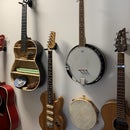Introduction: Guitar Music Theory Tools
This instructable is about taking complex (western) music theories and simplifying them into easy to understand tools.
The tools used in this instructable have been both invented, developed and stolen from other tools that are around. All the templates and downloads are my own creations.
In this video I use and mention the Circle of Fifths. This has been covered in my previous instructable. All instructions downloads and details on how to make your own are covered in that instructable.
This instructable covers two simple tools to shape the way that you understand music theory. I've developed the tool for understanding guitar, cello, 4 string banjo and 5 string bass, but it could be easily tweaked to work for other stringed instruments once you understand how it works.
Step 1: Printing Out the Tools
All the tools are printable in the PDF file above.
The file includes enough tools to make about 5 guitar tools, one ukelele, one 5 string bass and one cello/4 string banjo tool.
Page one and two need to be printed on transparency.
Page 4 needs to be printed in colour... (well, I guess it doesn't have to, but it's easier to use that way)
It helps to laminate most of these files too. Just to make them last longer.
Attachments
Step 2: Woodwork on the Slider.
You could just make it out of cardboard or just use them loose.
For the wood working, I placed the pieces on some wood to figure out the size, then marked it and cut it out.
I used a router with a dovetail bit and cut a groove for the chords to slide in.
I hole punched the scale patterns and lay one on the piece of wood. I marked out the holes and drilled them.
I twisted some wire around some dowel and cut it into two rings I put the rings through the holes of the wood and slipped the scale patterns on before closing the rings.
I then took the printed files that have the mirrored patterns for a little symbols that highlights the different notes present in the scale. I laid it down where I wanted it, taped one end down and used a wood poker to heat the ink onto the wood. Be careful not to do it too much else you'll just burn the wood, you can lift it up afte each symbol and check how your technic is going. On the reverse side of the wood, I used this same technic to put little instructions that name each symbol.
By the way, I just made these symbols up, there probably is proper symbols for them. The only one I could find was the diminished symbol, so I just went with that and made up the rest.
Step 3: Understanding Keys
Within western music, there are 12 notes in total before they begin to repeat themselves.
Because the speed of sound is relatively regular, the frequency of a wave and the length of a wave are opposite. The longer the length of the wave, the lower the frequency of waves.
Wave frequency is measured in hertz and everything is built around and measured in relation to 440 hertz which is an A note.
If the frequency is doubled, it will be an octave and 880 hertz is another higher pitched A note. Again, if it is halved, it is an octave lower and 220 hertz is another A note. So the other 11 notes are the space between one note and the next octave.
The notes in a western musical scale are A A# B C C# D D# E F F# G G# A
What does all this have to do with scales? Well... certain wavelengths of sound will compliment others and their peaks and troughs will match up more often. When an instrument vibrates, it never just gives off a single tone it will resonate in a number of notes at once, some louder and some softer. All related to each other in unique ways. If one note compliments another, it will amplify it and resonate well alongside it. The waves might line up every 4th note, or every 3rd note. Other waves interfere with the original wave and add an irregularity to it. They create a tension in the listener. This is why music from some other cultures can sound haunting or spiritual. They may have more notes than 12, or they may emphasis tense notes.
Think of these mathematical fractions:
12/12, 11/12, 10/12, 9/12, 8/12, 7/12, 6/12, 5/12, 4/12, 3/12, 2/12, 1/12
Some of the fractions can be simplified very easily and some can't be simplified at all.
Some have more in common with the original number.
Within this system, there are 7 notes that just tend be friendly with each other, but they change depending on the note they are compared with.
In the Key of C Major, these notes are:
C D E F G A B C - These are the white keys on a piano.
C Major is an easy key to remember because it has no sharps or flats (black keys on a piano). In the Major scale the notes all work kindly in relation to the root note. This creates a happy go lucky kind of sound and is the centre piece of most pop music.
But... wait! What if you don't like pop? What if you want to sound different, spooky, sad, ethnic or spiritual? Well... You change the notes you pick and their distance from the root note or the key.
Notes are spaced apart by either a whole step (2 notes) or a half step (the next note). Ie. C is related to C# by a half step, but is a whole step from D.
On the scale finder, the notes are marked for each scale showing where each note in placed in relation to the root note. This shows you the patterns for various different modes of playing.
The notes on the scale finder are marked on a piece of paper that can slide along to choose your root note. When the root note is chosen, you can then see the names of each note in the scale.
Step 4: Using the Chord Finder
In basic terms, it is a bunch of notes all played together. It's that simple, because essentially you can put any notes together, but how and when you do it might mean the difference between generating feelings of disgust, unrest or joy.
For now, let's talk about a few simple ones.
Remembering what we learned about keys and scales, we know that there are 7 notes that play nice with a root note.
Lets look at the C major scale and the C major chord
1....2....3.....4.....5.....6.....7....8
C....D...E.....F.....G....A.....B....C
In the C Major chord there are three notes. The 1 the 3 and the 5.
The Major 3rd is always 4 notes or two whole steps from the root note.
Ie in C = C, C#, D, D#, E or in D = D, D#, E, F, F#.
The Major 5th is always 7 notes or 3 whole steps and a half step from the root note.
Ie in A = A, A#, B, C, C#, D, D#, E
This consistency means that on a stringed instrument, the notes are always in familiar patterns in relation to each other. These chord shapes can be moved up or down the neck, shortening the vibration of the strings, and therefore the length of the sound waves they produce. This changes the notes in the pattern and produces a different chord.
So the chord finder works by outlining the 1, the 3 and 5 notes. You can choose the chord you want to learn by putting a 1 of the transparency over on the root note of the chord you want to learn.
Instantly you can see all the possibilities for playing the chord all the way up the neck of your instrument.
Ok, cool for Major chords, but what about the minor chord? Well, just find all the 3rds in the chord shape, drop them back one fret and it's now a minor chord!
Ok, but what about a 7th, a sus4, a 9th or 13th chord?
Learn the scale, find the note to add in.
If it's a minor chord, use the minor scale. For a major chord, use the major scale. Add the note that is the 4th note in the scale for a sus4, 2 for a sus2, the major 7th or minor 7th for a 7th chord, etc.
Yes, but if there are only 7 notes, what about 9ths or 13ths? Well... keep counting the same 7 over again. A 9th is just a 2nd note, but an octave higher.
13th is just a 6th note an octave higher.
Diminished chord? Well, minor chord, but with all the 5ths dropped a half step.
Augmented? Ok... I've still got to work these ones out, but as far as I can tell, you can just keep adding notes and moving notes about, there are infinite combinations (although sometimes you'll do something you think is really clever and find out that it's just the same notes as a very standard chord, just played in an unexpected formation.
Step 5: Designs for Inkscape
This file is the SVG file to develop your own tools for other instruments, add other theories or scales (and post them in the comments for us all to enjoy).
Attachments

Participated in the
Explore Science Contest 2017

Participated in the
Untouchable Challenge













